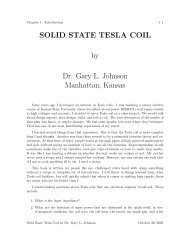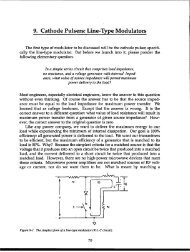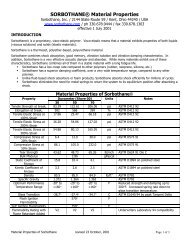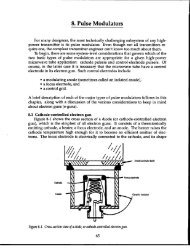3.6M north10.pdf - Dean-O's Toy Box
3.6M north10.pdf - Dean-O's Toy Box
3.6M north10.pdf - Dean-O's Toy Box
Create successful ePaper yourself
Turn your PDF publications into a flip-book with our unique Google optimized e-Paper software.
Cathode Pulsers: Hard-Tube Modulators (10) 195<br />
LA!!!K2-<br />
N=6.4<br />
Positive<br />
return<br />
Id.<br />
40CHIA peak 50-kV PSI( @W 500 A 500 A ‘500A 500A 500 A 500 A 500 A 500 A<br />
primaryvolta~ 4 ohms .40hms 4ohms 4ohms, 4ohms 401UTIS 4 ohms , 4 ohms<br />
1<br />
600 kVdc,40 A -.. --- --- --- --- --- --- ---<br />
Nsgativehigh<br />
voftsgefrom<br />
capacitorbank<br />
>1.7i:b,! ‘!b,-!-!&<br />
Grkl driver<br />
Modulatorgate in<br />
d<br />
up-ramp<br />
network<br />
60-kV isolation<br />
— pulsetransformer<br />
~ght psti!d WL%461 tfklch SWifChtllbas<br />
Figure 10-34. Simplified schematic diagram of “200-MW modulator using WL-8461 triodes,<br />
10.7 Some practical examples of hard-tube modulators<br />
Now let’s look at some applications of a couple of these switches.<br />
10,7.1 The 200-MW triode WL-8461) hard-tube modulator<br />
A hard-tube pulse modulator was actually built using eight parallel-connected<br />
WL-8461 triode switch tubes coupled to a super-power klystron load through a<br />
320-kV output-pulse transformer. Its simplified schematic diagram is shown in<br />
Fig. 10-34. Each of the triodes was to be operated with peak plate current of 500<br />
A (for a total primary-loop pulse current of 4000A) and a supply voltage of 65<br />
kVdc, which is adequate to support a 50-kV primary voltage output pulse with<br />
as much as 15-kV switch-tube anode-voltage drop.<br />
Although several identifiable pulses at the 200-MW peak-power level were<br />
actually obtained, the modulator was never capable of continuous, repetitive<br />
operation at this level. The operation of the electronic crowbar in response to<br />
individual switch-tube arcs was far too frequent an occurrence, even at output<br />
levels below 1OO-MW peak. This was an experimental modulator, however, and<br />
much was learned from it. One empirical lesson, which has not added much to<br />
an analytically satisfying data base, was that the performance demonstrated by a<br />
single tube operating alone could not be repeated when the tube was operated in<br />
parallel with others trying to do the same thing. It might be expected, for instance,<br />
that if an individual tube had an average period between internal arc<br />
events called T, an ensemble of n such tubes in parallel might have an average<br />
spark-down interval of T/n. The observed interval was much shorter than that.<br />
Internal switch-tube arcs are presumably random, non-synchronous events.<br />
Extensive diagnostic checks were used, including broad-band delay lines to de-<br />
\







